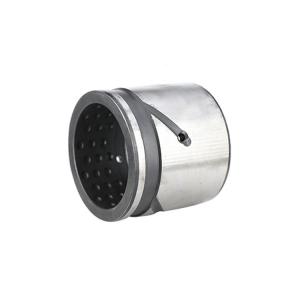
Add to Cart
High Precision Customized Cnc Machining Of Shaft Sleeve Hardened Sleeve Steel Bushing
A shaft sleeve bushing, also known as a shaft sleeve or shaft bearing, is a cylindrical component that provides support and reduces friction between a rotating shaft and its housing or bearing. It is typically made of a self-lubricating material, such as bronze or a composite material, to allow smooth rotation while minimizing wear.
Benefits of shaft sleeve bushings:
Friction reduction: Shaft sleeve bushings are designed to reduce friction between the rotating shaft and housing, minimizing wear and extending the life of the components.
Self-lubrication: Many shaft sleeve bushings are self-lubricating, which means they have embedded lubricants or are made from materials that inherently provide lubrication. This reduces the need for additional lubrication and maintenance.
Noise and vibration reduction: The smooth rotation facilitated by shaft sleeve bushings helps reduce noise and vibration in rotating systems, enhancing overall performance and user comfort.

| Performance Index | | Data | |
| Hardness | HRC | 58-62 | |
| Max Load | N/mm2 | 250 | |
| Max Linear Velocity | m/s | 0.1 | |
| Max PV Value | N/mm2.m/s | 1.5 | |
| WorkingTemperature Limit | ℃ | -100~ +350 | |
| Linear Expension Coefficient | 10-5/℃ | 1.1 | |


| Performance Index | | Data | |
| Hardness | HV | ≥650 | |
| Max Load | N/mm2 | 200 | |
| Max Linear Velocity | m/s | 0.1 | |
| Max PV Value | N/mm2.m/s | 1.5 | |
| WorkingTemperature Limit | ℃ | -100~ +350 | |
| Linear Expension Coefficient | 10-5/℃ | 1.1 | |

| Performance Index | | Data | |
| Hardness | HV | ≥650 | |
| Max Load | N/mm2 | 200 | |
| Max Linear Velocity | m/s | 0.1 | |
| Max PV Value | N/mm2.m/s | 1.5 | |
| WorkingTemperature Limit | ℃ | -100~ +350 | |
| Linear Expension Coefficient | 10-5/℃ | 1.1 | |

| Material and bushing characteristics | | value | Company | value | |
| Maximum load | Mpa | 100 | psi | 145,00 | |
| working temperature | ℃ | -40 to 300 | °F | -40 to 572 | |
| Max Linear Velocity | m/s | 0.5 | fpm | 100 | |
| Maximum PV Value | m/sxMPa | 1.65 | pis x fpm | 48,000 | |
| Minimum hardness of sliding layer | HB | 210 | HB | 210 | |
| Minimum hardness of dual parts | HRC | 40 | HRC | 40 | |








